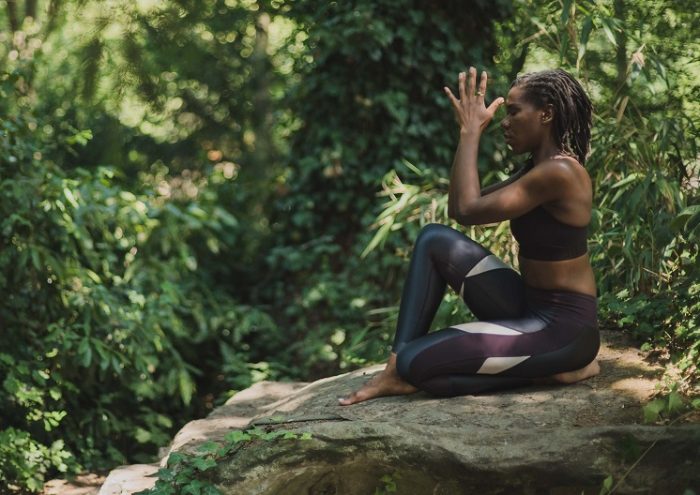This is the third in a series of articles, A Yoga Course in Miracles: exploring the 10 basic principles of yoga, and how each principle can be practiced not only on the yoga mat, but also in our day-to-day lives to liberate us through love. Read the first here and the second here.
Many yoga postures are based on the movements of animals and the way they stretch.
But, take the time to actually watch an animal stretching, and you’ll see that it’s short and sweet and all over in just a few seconds—quite unlike a yoga posture or asana.
A doggy will stretch, a pussy will stretch, even a bunny will stretch from time to time, but a yogin who understands what asana actually is will have a very different intention in mind.
When I’m teaching yoga I’m careful with my vocabulary, I do not use the word stretch, and I encourage my students to let go of the intention to stretch entirely. This can be something of a surprise to my new students.
Stretching fits in neatly with our Westernised version of yoga as a kind of spiritual-lite sport or a perpetual performance in the Cirque du Soleil. But stretching teaches us to keep looking for more, to do more, to be more, to keep performing, just like the edicts of sports psychology and the circus promote.
But yoga is not a sport, neither is it a circus act, despite the exotic dancing of yoga porn performances on social media.
The purpose of yoga is not to condition us to continually look for more, but rather to see where we actually are: afloat on an ocean of love.
The purpose of yoga is not to compel us to always do more, but rather to be who we truly are: a wave on a cosmos of conscious bliss.
The purpose of yoga is not to promote the ideal that we can be more, but rather that we already are that which we seek: a tear on the cheek of the divine.
So if I’m not teaching my students to stretch in asana, then what am I actually teaching them—besides being a blissful tear on the cheek of god falling into an ocean of love?
I’m teaching aparigraha, the third of the authentic yoga qualities.
Aparigraha is one of the foundation stones of our yoga practice. The Sanskrit word can be translated as openness.
On the yoga mat this translates as openness in our exploration of asana; it is one of the many words that can be used instead of the one-size-fits-all “stretch.”
Skeletal joints open, they are not stretched. Muscles are extended, they are not stretched. The body is lengthened, broadened, expanded, released, softened, and surrendered. But stretched? Not really.
Dismissing this specificity as semantics is really a lazy excuse to avoid deeper inquiry and cultivate a clearer understanding of the motivation, method, and mindset of what asana really is.
A key yoga word that can be used to deepen our understanding of asana is extension.
I tend to use a silly joke to explain this essential word to my students, but it gets the point across:
“Ex-tension, is just like an ex-boyfriend, meaning boyfriend was present, and then boyfriend is gone. Ex-tension means, tension was present, and then tension is gone.”
This explanation and application of the word tension gives a yoga student a clear understanding of what a yoga posture is, and the motivation they should be cultivating in their practice. But what is the method and mindset of extension in contrast to the generic instruction of stretching?
We should move as slowly as possible into a yoga posture via the breath, listening carefully to the thoughts and feelings that arise.
If you encounter tension then stop, this is your limit—what I call the edge. At the edge, focus on the slowness of your breath, and direct your breath to each point of tension in your body-mind. Harness the breath to create space, stability, and softness.
When you are at a fork in the yoga road, the right way is to explore sensitive extension, the wrong way is to push through the tension and seek more in a stretch.
On the right path you breathe gently, and you wait patiently. Through your attitude of sensitivity, honesty, and patience, the body-mind releases it tension and relaxes. It is via this internal alchemy that the edge moves spontaneously deeper into the asana, and the body-mind opens. You have become an alchemist, a transformer of tension into ex-tension—this is aparigraha.
To the untrained eye you will appear to be stretching, but to the well-trained yoga teacher you will be practicing asana: joyful steadiness and ease in the body-mind, free from tension, manifesting the infinite beyond duality.
The motivation of a yoga posture is simply to release tension, mentally, emotionally, and physically, and thereby bring our whole being into balance. Nothing more.
Conversely, stretching tends to create tension in the body, in the mind, and in the heart. This is primarily because the motivation, method, and mindset is to ambitiously seek more, to push for more, to demand more, rather than cultivating contentment and just enjoying being where we are.
Over the years I have encountered so many super supple yogins, yet they remain highly strung, highly stressed, and dissatisfied. The reason is simply that they have only ever been taught to stretch, they have only ever been told: there are no limits and the journey never ends.
As a consequence, they are rarely at peace, having been conditioned to always want more on a never-ending journey where they are forever searching. The epitome of Western dis-ease.
When we divorce the genuine Eastern philosophy from yoga and marry it with Western pop psychology, we end up with a culture of excitable circus performers in loud leggings, instead of calm yoga practitioners in quiet humility.
A yoga posture is practiced for peace, it is not a performance piece.
As a community, we have been irresponsible and negligent in allowing yoga to become a parody. It’s time to reclaim our art form.
As yoga teachers, we have a responsibility to teach the real thing and not drive our students to stretch. As yoga students,we have an equal responsibility to request the real thing, and not allow ourselves to be driven to stretch, either by our own ambition or by the ambition of others.
Through patient practice on the yoga mat, openness becomes assimilated in our every fibre, fascia, and form—assimilated in the very heart of our being. It then becomes an entirely natural response to relate to others just as we have learned to relate to ourselves on the yoga mat.
In this natural bridge from yoga mat to our day-to-day life we are then able to judge with an open heart and mind between what gives to us and makes us rich in spirit, and what takes from us and makes us poor in prana (energy).
Openness in our hearts and minds communicates openness to other hearts and minds, just as surely as fear closes us to our complete potential. The age-old human condition.
Where will this fear end? It ends with you in asana, in your body and soul, in your heart and mind.
With the heartfelt practice of aparigraha, on and off the yoga mat, you can be the change you want to see in the world.


 Share on bsky
Share on bsky





Read 0 comments and reply